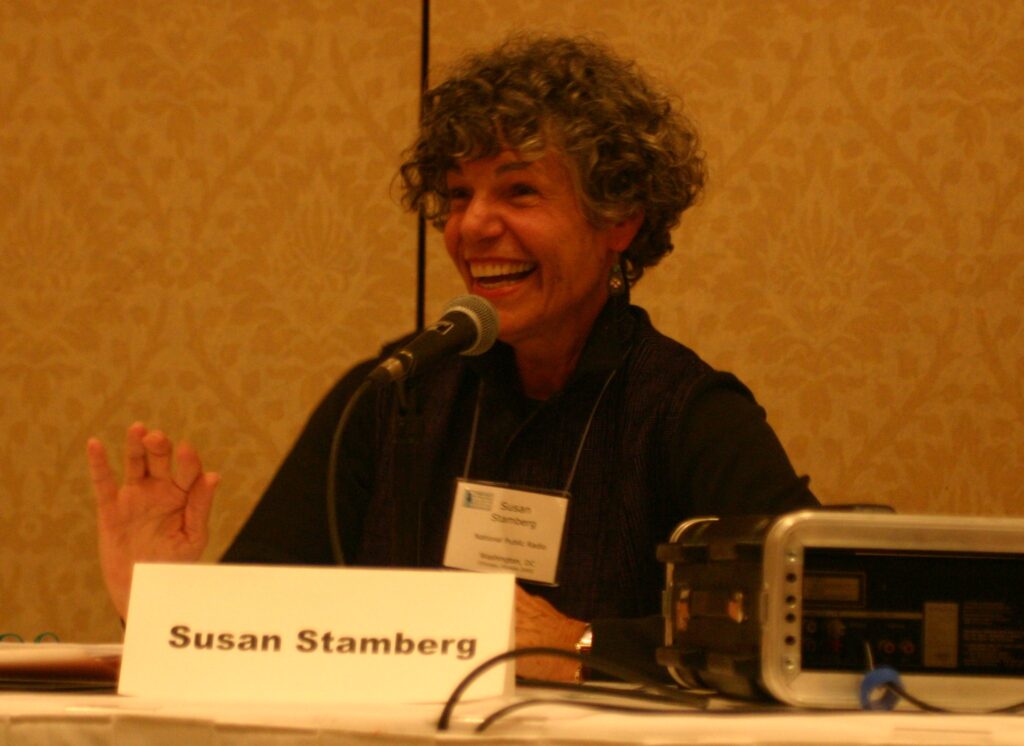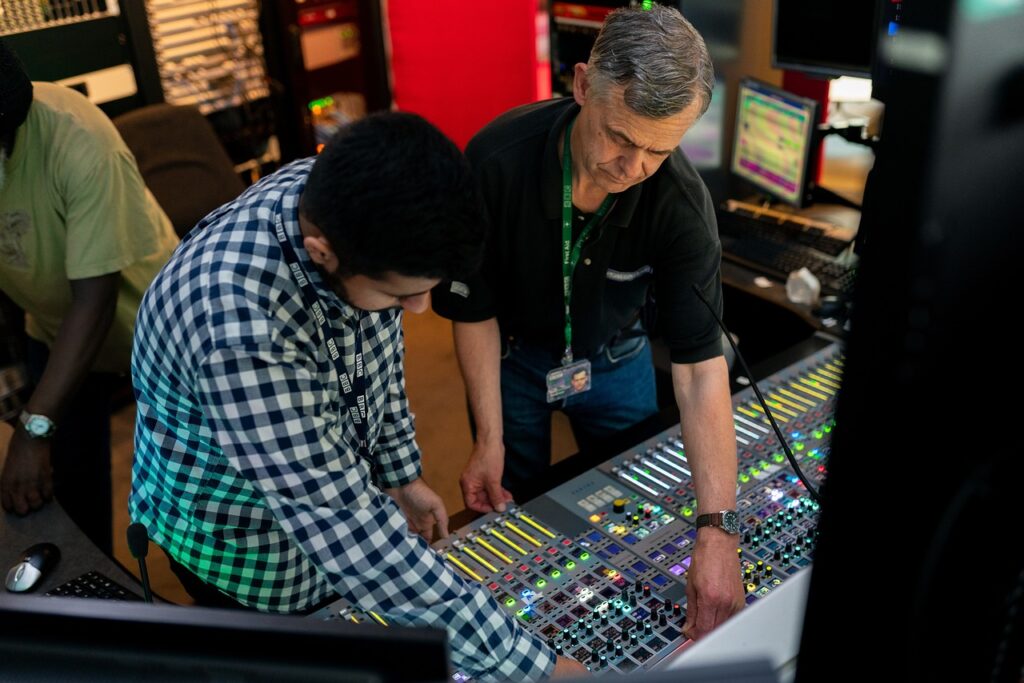
Susan Stamberg, a distinctive and enduring voice on National Public Radio for more than 50 years and a central figure in the network’s genesis, has died at 87. Her passing on Thursday was announced by NPR, which did not specify a location or a cause of death. Ms. Stamberg, who retired in September, left behind a legacy that fundamentally reshaped broadcast journalism, particularly for women, and helped define the sound and character of NPR itself.
As the first woman to anchor a national evening news broadcast in 1972, Ms. Stamberg brought an earthy informality and a pointed questioning of newsmakers to her role on “All Things Considered.” She was instrumental in creating an auditory landscape that departed from the rigid, male-dominated norms of her era. Her career was a testament to authenticity and an unwavering commitment to finding compelling human stories, whether from prominent public figures or those working quietly behind the scenes.
Her influence extended far beyond the microphone, encompassing innovative programming, a celebrated interviewing style, and a remarkable ability to connect with listeners on a deeply personal level. This article examines the enduring contributions of Susan Stamberg, celebrating her pioneering spirit and the indelible mark she left on American public media and the broader cultural landscape.

1. **A ‘Founding Mother’ of National Public Radio**Susan Stamberg was not merely an employee of National Public Radio; she was, by her own coinage, a “founding mother,” a term she proudly declared to distinguish herself and her female colleagues from the pervasive historical narrative of “Founding Fathers.” She explained in an oral history interview with Oregon station KLCC in January that she “got tired of hearing about Founding Fathers, and I knew we were not that, so we were obviously Founding Mothers, and I was going to put that on the map.” This designation underscored the critical role she played, alongside Nina Totenberg, Linda Wertheimer, and Cokie Roberts, in building NPR from its nascent stages in the early 1970s.
When Ms. Stamberg joined the fledgling network, it was just getting off the ground as a collection of radio stations across the country, starting with its original 63 member stations. In an era when mainstream newsrooms often overlooked talented female journalists for hard-news assignments, NPR provided a unique opportunity. The network’s ability to scoop up these skilled women allowed them to bring their distinctive voices and perspectives to radio news, fundamentally shaping NPR’s identity and establishing its credibility.
Her commitment to establishing this new public broadcaster was profound. It involved not just reporting, but also defining what public radio could be. The term “founding mother” itself became emblematic of the collaborative and pioneering spirit that characterized NPR’s early years, recognizing the often-unacknowledged contributions of women in shaping a national institution.
Read more about: Chi Chi Rodriguez, Golf’s Ebullient Showman and Humanitarian, Dies at 88: A Legacy of Flair, Heart, and Unforgettable Impact

2. **The First Woman to Anchor a National Evening News Broadcast**In 1972, Susan Stamberg made history by becoming the first woman to anchor a national evening news broadcast, “All Things Considered.” This appointment was a seismic shift in an industry overwhelmingly dominated by men. Before her, women in broadcast were often confined to less prominent roles, or, if on air, were typically trained actors delivering content with “very careful accents and very careful delivery.” Ms. Stamberg shattered this mold, bringing an authentic and immediate presence to the airwaves.
Her tenure as host of “All Things Considered” lasted for 14 years, through 1986. During this period, the program rapidly grew in prestige and seriousness, becoming NPR’s marquee broadcast. It played a pivotal role in solidifying the network’s reputation and expanding its reach far beyond its initial cohort of stations. Her pioneering role was not just about gender; it was about demonstrating that a woman’s voice could carry authority, intelligence, and warmth in the serious realm of national news reporting.
This groundbreaking achievement opened doors and redefined expectations for future generations of female journalists. It challenged the prevailing assumptions about who could deliver news with gravitas and who could connect with a national audience, thereby leaving an indelible mark on the landscape of American journalism and fostering a more inclusive environment.
Read more about: The Unforgettable Fails: 14 TV Hosts Whose Careers Crumbled After One On-Air Gaffe

3. **Forging a New Sound: Authentic Voice and New York Accent**When Susan Stamberg first began her career in broadcasting, the prevailing wisdom, and indeed her own initial instinct, was to conform to the established male norms. She recounted in an oral history interview that she “didn’t have women in broadcast to model herself after when she became the host of ‘All Things Considered’ in 1972.” Consequently, she found herself imitating the men on air, even lowering her voice to sound more authoritative in an effort to fit the mold.
However, this period of imitation was short-lived. After just a few days, Bill Siemering, NPR’s first program director, offered her pivotal advice: “Be yourself.” This directive was revolutionary for its time. Ms. Stamberg explained that this approach meant creating a “new sound with radio as well, with NPR,” one that was “relaxed and natural,” in stark contrast to the “careful accents and very careful delivery” of trained actors who were typical of female broadcasters then. Her natural voice, described by her colleague Jack Mitchell as an “obvious New York accent,” became a signature element of NPR’s distinctive auditory identity.
Despite the progressive vision of NPR’s leadership, Ms. Stamberg faced resistance from some quarters. She recalled objections from station managers who asserted that “women’s voices were not as authoritative.” Yet, Siemering’s vision persisted, emphasizing a desire to hear “voices on our air that we’d hear across our dinner tables at night or at the local grocery store.” Stamberg’s embrace of her authentic self, with her distinctive accent and conversational style, not only defied these biases but became a cornerstone of NPR’s approachable and trusted sound.

4. **The Art of the Interview: Deep Preparation and Active Listening**Susan Stamberg was celebrated throughout her career as a skilled interviewer, distinguished by her meticulous preparation and a remarkable capacity for active listening. These qualities allowed her to engage deeply with her subjects, often eliciting insights and candor that others might miss. She once described herself to Newsday in 1993 as a “natural schmoozer,” conveying her innate ability to connect with people and foster an environment of trust and openness.
Her interviewing prowess extended to thousands of individuals, spanning the spectrum from prominent politicians and artists to less well-known figures such as White House chefs and those who work behind the scenes in Hollywood. Among her notable interview subjects were President Jimmy Carter, then-First Lady Laura Bush, the civil rights leader Rosa Parks, and the opera star Luciano Pavarotti. She also interviewed Nancy Reagan, Annie Liebowitz, and James Baldwin, showcasing the breadth of her interests and her talent for engaging diverse personalities.
Perhaps one of the most revealing examples of her skill was her 1977 interview with the notoriously reticent and “wispy-voiced” author Joan Didion. Ms. Stamberg’s engaged questioning enabled Didion to open up, leading to a profound admission. When Ms. Stamberg suggested that Didion might never win a Nobel Prize because her fiction was so bleak, Didion acknowledged, “I am more attracted to the underside of the tapestry. I tend to always look for the wrong side, the bleak side.” This moment exemplified Stamberg’s ability to probe thoughtfully and draw out deeply personal reflections, making her interviews memorable and impactful.
Read more about: 15 Critical Mistakes to Avoid in a Job Interview: Expert Insights for Professional Success
5. **An ‘Oil-and-Vinegar Mixture’: Co-hosting ‘All Things Considered’ with Bob Edwards**In 1974, NPR introduced a new dynamic to “All Things Considered” by pairing Susan Stamberg with Bob Edwards, a Kentucky native, as co-hosts. This collaboration, described as an “oil-and-vinegar mixture,” proved to be immensely successful in enlivening the program. Their contrasting personalities and broadcasting styles created a compelling synergy that captivated listeners and became a defining characteristic of the show for five years.
Ms. Stamberg’s on-air presence was marked by her spontaneity, often punctuated with genuine giggles, reflecting her relaxed and natural approach to journalism. This contrasted sharply with Mr. Edwards’s persona, characterized by his cool, bourbon-smooth baritone. The interplay between Stamberg’s vibrant, immediate energy and Edwards’s calm, steady delivery created a balanced and engaging broadcast that resonated deeply with the burgeoning NPR audience.
The unique chemistry between the two hosts showcased NPR’s willingness to experiment with radio formats and personalities. Their collaboration further solidified “All Things Considered” as a destination for thoughtful news and engaging conversation. Mr. Edwards eventually departed in 1979 to host a spinoff program, “Morning Edition,” but the period of their co-anchoring remains a significant chapter in the history of NPR and a testament to Ms. Stamberg’s versatility and charm as a broadcaster.

6. **Setting the Standard for Daily News: ‘All Things Considered’ and its Challenges**Susan Stamberg’s 14-year tenure as host of “All Things Considered,” from 1972 through 1986, was a period of immense growth and definition for NPR. Under her stewardship, the weekday program of news, analysis, and interviews transcended its initial mandate to become the network’s flagship broadcast. It was during these years that “All Things Considered” truly began to bring both prestige and a profound sense of seriousness to NPR, allowing the network to expand rapidly beyond its modest beginnings of 63 member stations across the country.
The daily production of the 90-minute program presented significant logistical challenges, particularly in its early days. Ms. Stamberg recalled that the show often had only five reporters available to contribute content, demanding creativity and resourcefulness to fill the extensive airtime with compelling and substantive material. This continuous daily challenge forged a resilient team and a rigorous journalistic standard that would become synonymous with NPR.
Through her consistent presence and groundbreaking approach, Ms. Stamberg instilled a commitment to in-depth reporting and nuanced analysis that became a hallmark of public radio. Her work on “All Things Considered” laid a critical foundation for NPR’s reputation as a trusted source of news, fostering an environment where complex topics could be explored thoroughly, and diverse perspectives could be heard. This enduring framework continues to shape NPR’s programming to this day, a direct legacy of her foundational leadership.

7. **Innovative Program Development: ‘Weekend Edition Sunday’ and the Puzzle Feature**After 14 years at the helm of “All Things Considered,” Susan Stamberg stepped down from the program in September 1986. This temporary hiatus was necessitated by her need to seek treatment for breast cancer, a personal challenge she faced with resilience. Her return to the airwaves the following January marked a new chapter in her illustrious career, one that would further diversify NPR’s programming landscape.
Upon her return, Ms. Stamberg embarked on a new endeavor: hosting “Weekend Edition Sunday.” This program offered a fresh format, allowing her to explore different avenues of cultural reporting and engagement. It was on this show that she introduced several innovative segments, demonstrating her continuous quest to evolve public radio’s offerings and connect with listeners in new ways.
One of her most celebrated innovations on “Weekend Edition Sunday” was the introduction of the Sunday puzzle feature, in collaboration with the renowned puzzle master, Will Shortz, who is now the crossword editor of The New York Times. Ms. Stamberg envisioned the show as the radio equivalent of a Sunday newspaper, a comprehensive offering that provided not just news, but also culture, sports, and, crucially, a stimulating puzzle for the listeners. This feature quickly became a beloved staple, cementing her legacy as a broadcaster who understood and catered to the varied intellectual curiosities of her audience.

8. **Cultivating Cultural Connections: Arts Correspondent and Unique Segments**Beyond her foundational work in news anchoring, Susan Stamberg consistently demonstrated a profound passion for culture and the arts. Following her tenure on “Weekend Edition Sunday,” she transitioned into a dedicated role as a cultural correspondent for both “Morning Edition” and “Weekend Edition Saturday.” This shift allowed her to delve deeply into the world of arts, a realm she openly admitted to preferring over the more contentious domain of politics.
She once stated that she “maintained that she had never liked talking to politicians and far preferred cultural figures,” highlighting a genuine inclination that shaped her later career. In this capacity, Ms. Stamberg brought her distinctive interviewing style and knack for finding compelling stories to a broad array of artists, performers, and creators. Her cultural reporting was characterized by the same warmth, intelligence, and insightful questioning that defined her news interviews, making complex artistic expressions accessible and engaging to a national audience.
Her cultural segments on “Weekend Edition Sunday” showcased this unique approach. She shared recipes from celebrated chef Alice Waters, bringing a culinary dimension to public radio, and featured insightful movie reviews by the cartoonist Jules Feiffer. These varied contributions underlined her belief that public radio should be a rich tapestry of information and entertainment, fostering a deeper appreciation for the cultural fabric of American life.

9. **Connecting with Public Figures: The Jimmy Carter Call-In Program**Susan Stamberg’s ability to navigate high-profile public engagements was unequivocally demonstrated in 1979, when she hosted a groundbreaking two-hour radio call-in program with then-President Jimmy Carter. This event took place directly from the Oval Office, signifying a remarkable level of access and trust placed in her journalistic capabilities.
During this unprecedented broadcast, Ms. Stamberg undertook the challenging task of managing listeners who called in to speak directly with the President. Crucially, the questions posed by the public were not screened beforehand, a testament to the transparency and authenticity that both NPR and President Carter aimed to convey. This format demanded not only her characteristic intelligence and conversational ease but also keen judgment and composure under immense pressure.
It was only the second time President Carter had engaged in such a direct, unscreened call-in program with the public, following a similar broadcast with Walter Cronkite. Stamberg’s role in this historic event underscored her standing as a respected and capable interviewer, capable of facilitating meaningful dialogue between a sitting president and the American citizenry, further solidifying NPR’s reputation for innovative and impactful public service journalism.
10. **Championing Emerging Voices: Launching ‘Car Talk’**Susan Stamberg’s influence extended beyond the traditional news desk and cultural reporting; she possessed a keen eye for identifying and championing unique voices that would eventually become beloved staples of public radio. A prime example of this foresight was her role in introducing the Magliozzi brothers, Ray and Tom, to a national audience.
These two auto mechanics were initially known for their local radio show on WBUR in Boston. Recognizing their distinctive charm, wit, and practical advice, Ms. Stamberg brought them to “Weekend Edition Sunday.” This exposure proved pivotal, as their segment quickly resonated with listeners across the country, highlighting her ability to cultivate diverse and engaging content for NPR.
The Magliozzi brothers’ popularity soared, leading to the eventual spinoff of their own quirky and immensely successful NPR show, “Car Talk.” This program, which broadcast original episodes until 2012, became a cultural phenomenon, celebrated for its humor, its hosts’ camaraderie, and its unlikely appeal to a broad demographic. Stamberg’s early championing of their unique brand of radio not only enriched NPR’s programming but also demonstrated her enduring impact on the network’s identity as a home for innovative and beloved voices.

11. **Enduring Legacy and Recognition: Hall of Fame and Hollywood Walk of Fame**Throughout her distinguished career, Susan Stamberg received numerous accolades, solidifying her place as a titan of American broadcast journalism. Her induction into the National Radio Hall of Fame stands as a significant testament to her profound contributions to the medium. The Hall of Fame recognized her specifically for her “conversational style, intelligence, and knack for finding an interesting story,” qualities that resonated deeply with millions of listeners over five decades.
This recognition underscores the unique blend of journalistic rigor and approachable demeanor that defined her work. It acknowledged that her impact went beyond merely delivering news; she cultivated a personal connection with her audience, making complex issues comprehensible and human-interest stories profoundly moving. Her ability to consistently uncover and present compelling narratives, coupled with her distinctive voice, created an indelible mark on the landscape of public radio.
In a further celebration of her lasting cultural significance, Ms. Stamberg received a star on the Hollywood Walk of Fame in 2020. This honor, typically reserved for luminaries in film, television, music, and theatre, highlighted her widespread recognition and the breadth of her influence. Her retirement in September, after more than 50 years on the air, marked the close of an extraordinary chapter, but her legacy, celebrated in these prestigious recognitions, continues to inspire and inform future generations of journalists.
12. **A Personal Touch: The Cranberry Relish Tradition and Final Reflections**Beyond her professional achievements, Susan Stamberg was known for cultivating a unique and endearing tradition that brought her closer to her audience: her annual Thanksgiving cranberry relish recipe. Beginning in 1971, she began sharing her family recipe for a distinctive relish, made with horseradish, with NPR listeners. This segment transcended mere culinary advice, becoming a cherished holiday ritual for many.
To add variety and a touch of celebrity flair, Ms. Stamberg would often invite prominent figures, such as Martha Stewart and the rapper Coolio, to read the recipe on air. This playful and personal touch became one of her most popular segments, demonstrating her ability to blend serious journalism with moments of lighthearted, communal connection. It illustrated the human element she brought to public radio, extending beyond news and analysis into the very homes and traditions of her listeners.
Reflecting on this unique aspect of her career, Ms. Stamberg humorously told NPR host Ari Shapiro during an interview upon her retirement that the cranberry relish tradition was “going to be on my obituary. It’ll be the lead, you know?” While a lighthearted remark, it perfectly encapsulated her understanding that genuine connection and relatable traditions are often as memorable as groundbreaking news. Her life, born Susan Levitt in Newark, New Jersey, in 1938, and raised in Manhattan, was one of dedication to both her craft and her audience. She is survived by her son, Josh, and her granddaughters, Vivian and Lena, leaving behind not just a legacy in media, but also a personal story woven into the fabric of American public life.
Susan Stamberg’s passing at 87 marks the end of an era for National Public Radio and for American journalism. Her career, spanning over five decades, was defined by a relentless pursuit of authenticity, a pioneering spirit, and an unwavering commitment to the listener. From coining the term “founding mother” to establishing the distinctive sound of NPR, from challenging the norms of broadcasting to connecting with presidents and chefs alike, she fundamentally reshaped how news and culture were delivered. Her voice, once an anomaly, became an iconic emblem of public radio’s promise — intelligent, intimate, and endlessly inquisitive. She leaves behind an institution profoundly shaped by her vision and a legacy that continues to resonate, reminding us of the power of genuine human connection on the airwaves.





